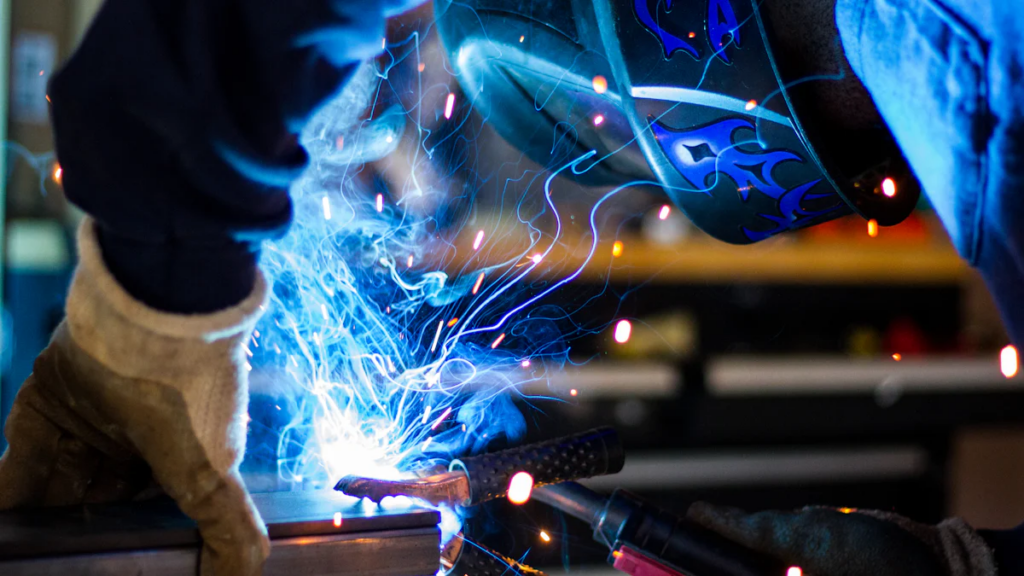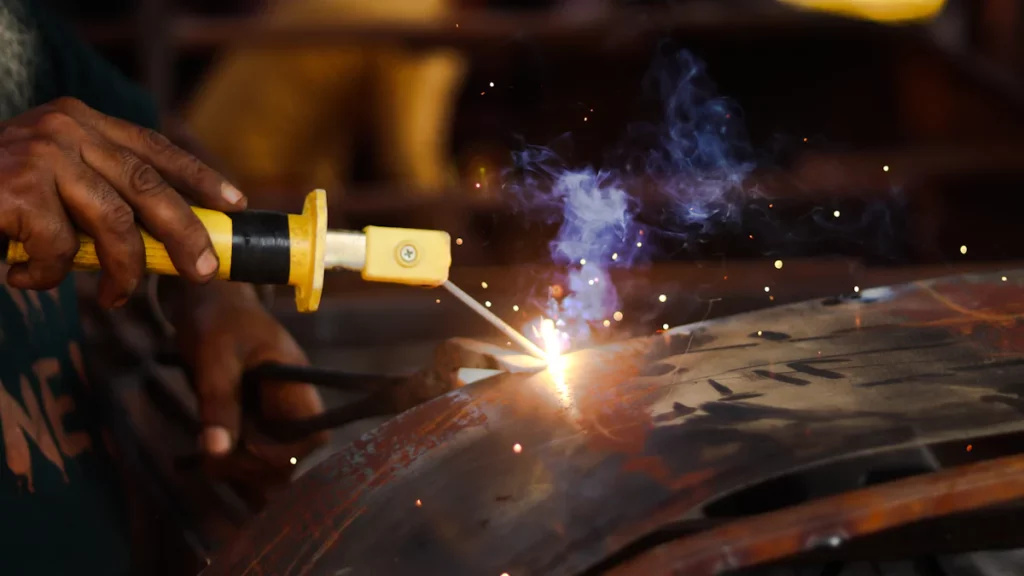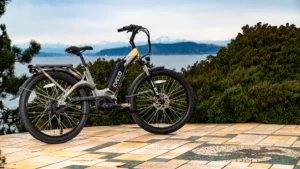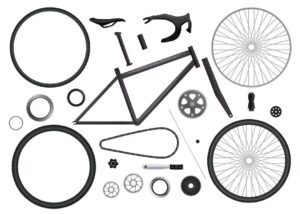كأفضل مادة لإطارات الدراجات, الألومنيوم هو خيار شائع, المحاسبة أكثر 40% حصة السوق. إن القدرة على تحمل تكاليف إطارات الألومنيوم تجعلها في متناول مجموعة واسعة من راكبي الدراجات مقارنة بألياف الكربون أو التيتانيوم. بالإضافة إلى ذلك, تشتهر إطارات الألومنيوم بمتانتها الاستثنائية, تحمل التضاريس والتأثيرات الخشنة مع الحفاظ على سلامتها الهيكلية. بالإضافة إلى, الألومنيوم قابلة لإعادة التدوير بدرجة كبيرة, يجذب الدراجين الواعيين بيئيا.
لكن, تنشأ التحديات في إطارات الألمنيوم لحامها بسبب إنتاج أبخرة خطرة تحتوي. فيما يتعلق بأهمية تقنيات اللحام المناسبة, اللحام TIG هو الطريقة المفضلة للانضمام إلى إطارات الدراجات الألومنيوم. يضمن اللحام TIG التحكم الدقيق في مدخلات الحرارة, تقليل احتمال ارتفاع درجة حرارة الإطار وإتلافها أثناء عملية اللحام.
لتعلم كيفية لحام إطار دراجة الألومنيوم, ستروي هذه المقالة خطواتها بوضوح وشامل من البدء إلى الانتهاء في عرض مصانع إطار الدراجات المهنية.

المواد والمعدات الأساسية لحام إطار دراجة الألومنيوم
قبل الغوص في عملية اللحام لإطار دراجة الألومنيوم, من الأهمية بمكان التحضير عن طريق جمع الأدوات والمواد اللازمة. يتطلب اللحام إطار دراجة الألومنيوم العديد من المواد والمعدات الأساسية:
- أنابيب الألومنيوم أو مكونات الإطار: تعد أنابيب الألومنيوم عالية الجودة أو مكونات الإطار المسبقة ضرورية لبناء الإطار.
- قضيب حشو لحام الألومنيوم: قضيب حشو متوافق مصنوع من سبيكة الألومنيوم أو الألومنيوم ضروري لإنشاء اللحامات القوية.
- تيغ (تنغستن الغاز الخامل) آلة اللحام: لحام TIG هو الطريقة المفضلة للحام الألمنيوم بسبب دقتها ومرضتها. يجب أن يكون للجهاز AC (تيار بالتناوب) القدرة على اللحام الألمنيوم.
- غاز الأرجون: يستخدم غاز الأرجون كغاز محامي أثناء لحام TIG لحماية تجمع اللحام من التلوث الجوي.
- قطب التنغستن: يتم استخدام قطب التنغستن غير القابل للاستهلاك لإنشاء قوس اللحام في اللحام TIG. تُستخدم أقطاب التنغستن التي يتم استخدامها بشكل شائع في اللحام الألومنيوم.
- طاحونة أو ساندر: يتم استخدام مطحنة أو صنفرة لإعداد الأسطح لتكون ملحومة عن طريق إزالة أي طبقة أكسيد أو تلوث.
- المشابك أو التركيبات لحام: هناك حاجة إلى المشابك أو التركيبات لعقد مكونات الإطار في مكانها أثناء اللحام, ضمان المحاذاة المناسبة.
- خوذة اللحام: من الضروري وجود خوذة لحام ذات مستوى ظل مناسب لحماية العيون من الضوء المكثف الناتج أثناء اللحام.
- قفازات لحام وملابس واقية: يجب ارتداء قفازات اللحام المقاومة للحرارة والملابس الواقية المناسبة للحماية من الحروق والشرر.
- مواد التنظيف: يتم استخدام المذيبات أو المنظفات لإزالة أي الأوساخ, زيت, أو بقايا من أسطح اللحام قبل اللحام لضمان اللحام النظيف.
- فرشاة سلك: فرشاة سلك مفيدة لتنظيف أسطح الألومنيوم وإزالة أي أكسدة قبل اللحام.
خطوة خبير لحام إطار دراجة الألومنيوم

بمجرد إعداد إطار دراجة الألومنيوم وجمع جميع الأدوات اللازمة, لقد حان الوقت للغوص في عملية اللحام. يتطلب اللحام إطار دراجة الألومنيوم الدقة والاهتمام بالتفاصيل لضمان منتج نهائي قوي ودائم. هذا الدليل خطوة بخطوة سيمشي بك خلال المراحل الأساسية من اللحام إطار الألومنيوم بشكل فعال.
تمرير اللحام الأولي: وضع الأساس
قبل البدء في عملية اللحام, درجة الحرارة والسرعة الصحيحة على لحام TIG حاسمة. الألومنيوم هو مادة موصلة للغاية تتطلب مدخلات حرارة أعلى من الصلب. يمكن أن تؤدي درجة حرارة عالية نسبيًا إلى ارتفاع درجة الحرارة والضرر المحتمل للإطار, في حين أن الإعداد المنخفض قد يؤدي إلى ضعف اللحامات.
ابدأ باللحام أو أقسام اللحام الفورية في الإطار معًا قبل إنشاء اللحامات المستمرة. هذا يساعد على منع التشويه والاختلال أثناء اللحام. حافظ على يد ثابتة وسرعة سفر ثابتة لضمان الاختراق والانصهار بين المعدن الأساسي وقضيب الحشو.
إكمال اللحام: ضمان القوة والمتانة
تعد الحرارة والتكيف الأمثل أيضًا عوامل حيوية مصنعو إطارات الدراجات الألومنيوم ركز دائما. الألومنيوم عرضة لنقل الحرارة السريع, تتطلب اليقظة المستمرة أثناء اللحام لمنع ارتفاع درجة الحرارة أو تسخينها. يضمن ضبط المدخلات الحرارية بناءً على سماكة المواد التي يتم لحامها الانصهار السليم دون المساس بالسلامة الهيكلية.
بمجرد الانتهاء من جميع تمريرات اللحام اللازمة, لقد حان الوقت لإنهاء اللمسات والتبريد. بعد إيقاف اللحام TIG الخاص بك, اسمح للمفاصل الملحومة بالتبريد بشكل طبيعي دون أي طرق تبريد قسرية مثل التبريد في الماء. يمكن للتبريد السريع إدخال الضغط في المعدن, يحتمل أن يؤدي إلى التكسير أو التشويه في المناطق الملحومة. افحص اللحامات النهائية لأي علامات على العيوب أو الانصهار غير المكتمل قبل المتابعة مع العلاجات اللاحقة.
بعد اللحام: ضمان سلامة اللحام
الانتهاء ليس هو النهاية. من الأهمية بمكان التحقق. يمكن أن تعزز المعالجة الحرارية بعد اليرلد قوة ومتانة إطارات الألومنيوم, خاصة بعد اللحام. هذا العلاج ضروري لتخفيف أي ضغوط متبقية تم تقديمها أثناء اللحام وتحسين الخواص الميكانيكية الشاملة للإطار.
عملية معالجة الحرارة معالجة إطارات الألومنيوم
تتضمن إطارات الألومنيوم المعالجة بالحرارة سلسلة من دورات التدفئة والتبريد التي تسيطر عليها لتحسين قوتها وصليتها. تتكون العملية عادة من ثلاث مراحل رئيسية:
- حل المعالجة الحرارية: في هذه المرحلة الأولية, يتم تسخين إطار الألومنيوم إلى نطاق درجة حرارة محددة حيث تذوب عناصر صناعة السبائك في محلول صلب. هذا يساعد على تجانس البنية المجهرية للمادة وإعداده لمزيد من التعزيز.
- التبريد: بعد الحلول المعالجة الحرارية, يتم تبريد الإطار بسرعة عن طريق التبريد في وسيط مناسب مثل محلول الماء أو البوليمر. هذا التبريد السريع “يتجمد” عناصر السبائك في مكانها, منعهم من العودة إلى حالتهم الأصلية.
- شيخوخة: تتضمن المرحلة النهائية شيخوخة الإطار في درجة حرارة مرتفعة لفترة محددة. هذا يسمح لترسبات دقيقة لتشكيل داخل المادة, زيادة قوتها وصلصتها بشكل كبير.
فحص اللحام والإطار
بمجرد أن يخضع إطار دراجة الألمنيوم الخاص بك, من الأهمية بمكان إجراء عمليات تفتيش شاملة للتحقق من جودة اللحام والنزاهة الهيكلية الشاملة. يمكن أن تساعد معرفة ما تبحث عنه في لحام جيد في تحديد المشكلات المحتملة في وقت مبكر:
- تحقق من التوحيد في ظهور حبة على طول المفاصل الملحومة.
- تأكد من عدم وجود تشققات أو مسامية مرئية داخل اللحامات.
- تحقق من الانصهار المناسب بين المعدن الأساسي وقضيب الحشو.
- ابحث عن أي علامات على ارتفاع درجة الحرارة أو التسخين أثناء اللحام.
يعد اختبار قوة إطارك بعد الدقة بنفس القدر من الأهمية في ضمان طول عمره وأدائه. يمكن أن يساعد إجراء اختبارات الإجهاد من خلال تطبيق الضغط التدريجي أو الحمل على أجزاء مختلفة من الإطار في تحديد نقاط الضعف أو الفشل المحتملة قبل أن تصبح مشكلات حرجة.
الأفكار النهائية
يجب أن تشبه خطوة جيدة التنفيذ حول كيفية لحام إطار دراجة الألومنيوم صفًا أنيقًا من الخرز, عرض الاختراق والقوة السليم. يشير التغير الخفي أسفل اللحام إلى اندماج شامل, ضمان سلامة المنتج النهائي. هذا الاهتمام بالتفاصيل أمر بالغ الأهمية عند العمل مع إطارات الألومنيوم, حيث تقنيات اللحام الدقيقة ذات أهمية قصوى.
- جون دو, عشاق اللحام:
“يجب أن يبدو اللحام الجيد وكأنه صف من الأوقات ويجب أن يكون هناك تلون معتدل للمادة تحت اللحام على ظهر القطعة حتى تعرف أن لديك تغلغلًا جيدًا.”
عند فحص إطارات دراجات الألمنيوم الصينية ذات السمعة الطيبة مثل تلك التي صنعتها تألق قريبا, من الواضح أن جودة اللحام تلعب دورًا مهمًا في تميز المنتج. هذه العلامات التجارية تعطي الأولوية لحامات نظيفة ودقيقة, ليس فقط للنزاهة الهيكلية ولكن أيضا للجاذبية البصرية. إن التكامل السلس لمكونات الإطار من خلال تقنيات اللحام الخبراء يعزز المتانة والجماليات للمنتج النهائي.
- جونز, متحمس ركوب الدراجات:
“لقد رأيت بعض اللحامات الرائعة في رحلة, تألق قريبا, ودراجات غاري فيشر التي مررت بها. تنظيف اللحامات تبدو رائعة.”

















